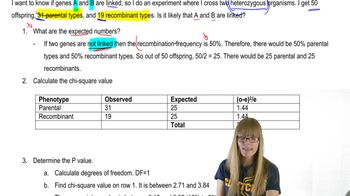What is the proposed basis for positive interference?
Table of contents
- 1. Introduction to Genetics51m
- 2. Mendel's Laws of Inheritance3h 37m
- 3. Extensions to Mendelian Inheritance2h 41m
- 4. Genetic Mapping and Linkage2h 28m
- 5. Genetics of Bacteria and Viruses1h 21m
- 6. Chromosomal Variation1h 48m
- 7. DNA and Chromosome Structure56m
- 8. DNA Replication1h 10m
- 9. Mitosis and Meiosis1h 34m
- 10. Transcription1h 0m
- 11. Translation58m
- 12. Gene Regulation in Prokaryotes1h 19m
- 13. Gene Regulation in Eukaryotes44m
- 14. Genetic Control of Development44m
- 15. Genomes and Genomics1h 50m
- 16. Transposable Elements47m
- 17. Mutation, Repair, and Recombination1h 6m
- 18. Molecular Genetic Tools19m
- 19. Cancer Genetics29m
- 20. Quantitative Genetics1h 26m
- 21. Population Genetics50m
- 22. Evolutionary Genetics29m
4. Genetic Mapping and Linkage
Crossing Over and Recombinants
Problem 13
Textbook Question
Two different female Drosophila were isolated, each heterozygous for the autosomally linked genes b (black body), d (dachs tarsus), and c (curved wings). These genes are in the order d–b–c, with b being closer to d than to c. Shown here is the genotypic arrangement for each female along with the various gametes formed by both:

Identify which categories are noncrossovers (NCOs), single crossovers (SCOs), and double crossovers (DCOs) in each case. Then, indicate the relative frequency in which each will be produced.
 Verified step by step guidance
Verified step by step guidance1
Step 1: Identify the parental (noncrossover, NCO) gametes for each female. These are the gametes that have the same allele combinations as the original chromosomes without any recombination. For Female A, the parental chromosomes are \( d\ b\ + \) and \( +\ +\ c \), so the NCO gametes are (1) \( d\ b\ + \) and (2) \( +\ +\ c \). For Female B, the parental chromosomes are \( d\ +\ + \) and \( +\ b\ c \), so the NCO gametes are (5) \( d\ b\ c \) and (6) \( +\ +\ + \).
Step 2: Determine the single crossover (SCO) gametes. Since the gene order is \( d - b - c \) with \( b \) closer to \( d \) than to \( c \), single crossovers can occur between \( d \) and \( b \) or between \( b \) and \( c \). For Female A, SCOs between \( d \) and \( b \) produce gametes (3) \( +\ +\ c \) and (4) \( d\ b\ + \), and SCOs between \( b \) and \( c \) produce gametes (5) \( d\ +\ + \) and (6) \( +\ b\ c \). For Female B, SCOs between \( d \) and \( b \) produce gametes (1) \( d\ b\ + \) and (2) \( +\ +\ c \), and SCOs between \( b \) and \( c \) produce gametes (7) \( d\ +\ + \) and (8) \( +\ b\ C \).
Step 3: Identify the double crossover (DCO) gametes. Double crossovers involve recombination events in both intervals (between \( d \) and \( b \), and between \( b \) and \( c \)). For Female A, the DCO gametes are (7) \( d\ +\ c \) and (8) \( +\ b\ + \). For Female B, the DCO gametes are (3) \( d\ +\ c \) and (4) \( +\ b\ + \).
Step 4: Assign relative frequencies to each category based on typical crossover frequencies. Noncrossover gametes (NCOs) are usually the most frequent because no recombination occurs. Single crossovers (SCOs) occur less frequently, and double crossovers (DCOs) are the least frequent due to the requirement of two crossover events. The exact relative frequencies depend on the recombination rates between the genes, but the order of frequency is generally: NCO > SCO > DCO.
Step 5: Summarize the results by listing each gamete category (NCO, SCO, DCO) for both females along with their expected relative frequencies, emphasizing the gene order and crossover positions to explain the patterns observed.
 Verified video answer for a similar problem:
Verified video answer for a similar problem:This video solution was recommended by our tutors as helpful for the problem above
Video duration:
3mPlay a video:
Was this helpful?
Key Concepts
Here are the essential concepts you must grasp in order to answer the question correctly.
Genetic Linkage and Gene Order
Genetic linkage refers to genes located close together on the same chromosome that tend to be inherited together. The gene order (d–b–c) indicates their physical arrangement, which helps predict crossover events. Knowing which gene is in the middle (b) is crucial for identifying single and double crossovers.
Recommended video:
Guided course

Chi Square and Linkage
Types of Crossovers: NCO, SCO, and DCO
Noncrossovers (NCOs) are gametes with parental allele combinations, single crossovers (SCOs) involve recombination between one pair of genes, and double crossovers (DCOs) involve two crossover events between three genes. Identifying these types helps determine recombination frequencies and gene distances.
Recommended video:
Guided course

Mutations and Phenotypes
Recombination Frequency and Gamete Proportions
Recombination frequency measures how often crossover events occur between genes, influencing the proportion of each gamete type. NCOs are usually most frequent, SCOs less so, and DCOs are rare. These frequencies help map gene distances and understand genetic variation.
Recommended video:
Guided course

Recombination after Single Strand Breaks
Related Videos
Related Practice
Textbook Question
1018
views


